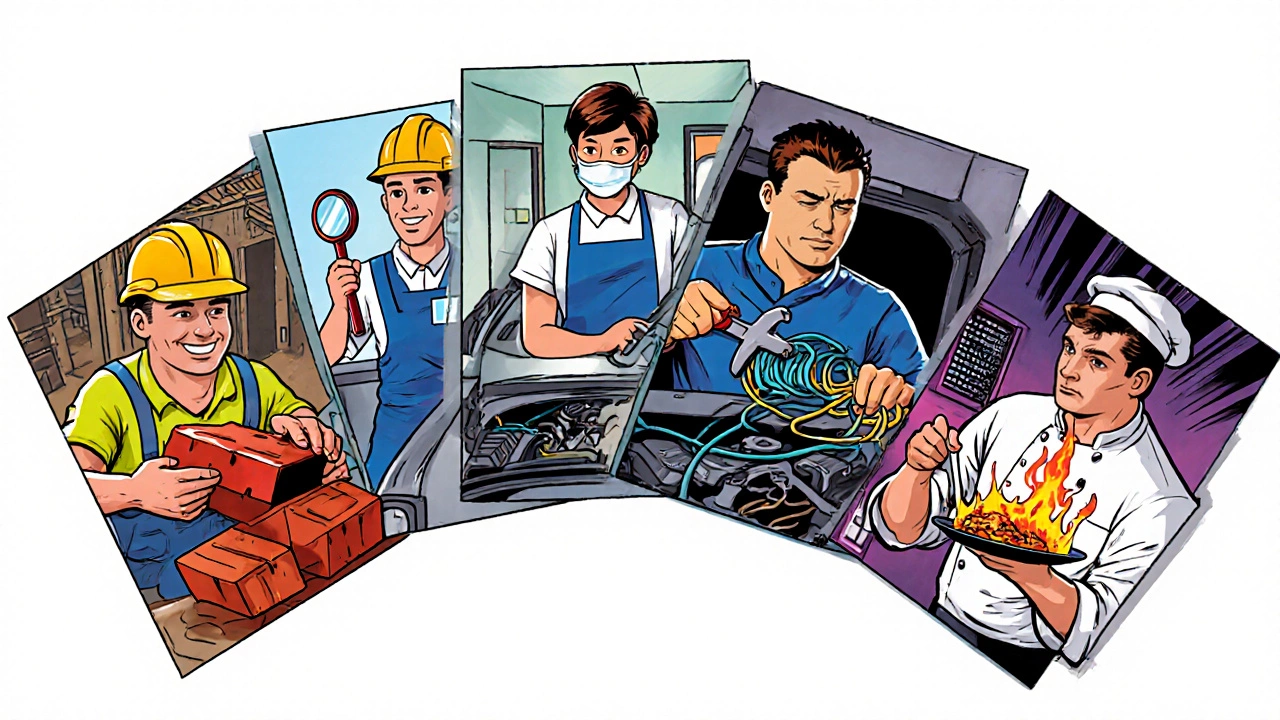Quick Takeaways
- A vocational job centers on specific skills learned through practical training.
- Apprenticeships, certifications, and trade schools are common entry routes.
- Jobs are usually tied to a defined occupational standard and clear career ladder.
- Hands‑on work dominates, while academic theory plays a supporting role.
- Employers value immediate job readiness and measurable competencies.
What Exactly Is a Vocational Job?
When you hear the word "vocational" you probably think of "trade" or "hands‑on" work. In formal terms, a vocational job is an occupation that requires specialized, skill‑focused training rather than a broad academic degree. The training often follows a national occupational standard and ends with a recognized credential, such as a trade certificate or a competency‑based qualification.
Unlike many university pathways that emphasize theory across multiple disciplines, vocational jobs aim to produce workers who can hit the ground running on day one. The focus is on measurable outcomes - can you weld a joint to specification? Can you diagnose a car engine fault? Can you install a residential electricity circuit safely? If the answer is yes, you’re looking at a vocational role.
Core Characteristics of Vocational Jobs
Four defining traits show up again and again across the world of vocational work.
- Skill‑Centred Training: Learning is organized around concrete abilities. For example, an Apprenticeship pairs on‑the‑job practice with classroom theory for a set period, usually 2‑4 years.
- Industry‑Validated Credential: Completion earns a certificate, licence, or diploma that employers recognise. In New Zealand, the NZQA (New Zealand Qualifications Authority) issues level‑4 to level‑6 trade certificates that map directly to job roles.
- Clear Occupational Standards: Every job has a set of standards defining the tasks, safety procedures, and performance metrics. The Dual Education System in Germany, for instance, codifies these standards into nationally‑aligned curricula.
- Direct Path to Employment: Employers often recruit straight from training programmes because the graduates already meet the job’s technical requirements.
Common Sectors and Real‑World Examples
Vocational jobs span dozens of industries. Below are some of the most recognizable fields.
- Construction: Bricklayer, electrician, plumber, carpentry foreman.
- Healthcare: Dental assistant, medical laboratory technician, paramedic.
- Automotive: Auto mechanic, diesel‑engine specialist, body‑shop technician.
- Information Technology: Network cabling installer, hardware repair specialist, CNC programmer.
- Hospitality: Chef, pastry cook, barista, hospitality manager.
Notice the pattern: each role hinges on a tangible set of tasks you can practice, assess, and certify.

How to Identify If a Job Is Vocational
When you’re scanning job listings, ask yourself these quick questions:
- Does the role require a specific trade certificate, licence, or competency‑based qualification?
- Is the training pathway listed as an apprenticeship, on‑the‑job training, or a trade school program?
- Are the daily duties described in terms of concrete tools, equipment, or processes (e.g., "operate a lathe" or "install HVAC systems")?
- Is there a clear career ladder (e.g., journeyman → master tradesperson) linked to the occupation?
If you answer yes to most of these, you’re likely looking at a vocational job.
Pathways Into Vocational Careers
There are three main routes people use to break into skill‑based occupations.
- Apprenticeship Programs: Companies partner with technical schools to combine paid work with classroom learning. In New Zealand, the Industry Training Organisations (ITOs) coordinate these placements.
- Trade School or Polytech: Full‑time study at a dedicated institution, often leading to a level‑5 or level‑6 certificate. For example, the Auckland Polytechnic offers a two‑year plumbing diploma.
- Short‑Term Certification Courses: Bootcamps or specialised short courses that give a fast‑track credential, such as a certification in welding or a first‑aid licence.
Choosing the right path depends on your learning style, financial situation, and how quickly you need to enter the workforce.
Benefits and Challenges of Vocational Work
Every career choice has trade‑offs. Here’s a balanced view.
| Aspect | Advantage | Potential Drawback |
|---|---|---|
| Entry Speed | Often ready to work within 1‑2 years | Limited time for broader academic exposure |
| Earning Potential | Competitive wages, especially in high‑skill trades | Salary growth may plateau without further specialization |
| Job Security | High demand for skilled hands‑on workers | Automation can affect certain manual trades |
| Flexibility | Opportunity for self‑employment or contract work | Irregular hours in sectors like construction |
Understanding these factors helps you decide whether a vocational route aligns with your life goals.

Vocational Jobs vs. Non‑Vocational (Academic) Jobs
| Dimension | Vocational Job | Academic/Non‑Vocational Job |
|---|---|---|
| Training Model | Skill‑focused, on‑the‑job or trade‑school | Degree‑focused, university‑based |
| Credential | Certificate, licence, competency badge | Bachelor’s, Master’s, PhD |
| Time to Workforce | 1‑3 years | 3‑7 years |
| Assessment | Practical exams, portfolio, on‑site evaluation | Written exams, research projects |
| Career Path | Clear ladder (apprentice → journeyman → master) | Varied - often research, management, or specialist tracks |
Both pathways produce valuable professionals; the choice hinges on how you prefer to learn and work.
Next Steps: Mapping Your Own Vocational Journey
Ready to test whether a vocational job fits you? Follow this short checklist.
- Identify a sector that sparks interest (e.g., construction, healthcare).
- Search for local Apprenticeship openings or trade‑school programs.
- Check the required credential - is it a NZQA level‑4 certificate, a licence, or a private certification?
- Speak with a career advisor or a tradesperson in the field to gauge day‑to‑day reality.
- Apply for a spot, start the training, and track your skill milestones.
Remember, vocational routes reward hands‑on effort. The more you practice, the faster you climb the ladder.
Frequently Asked Questions
Is a vocational job the same as a trade job?
Almost always. "Trade" is a subset of vocational work that involves skilled manual or technical tasks, such as plumbing or carpentry. All trades are vocational, but not every vocational job is a trade - think of roles like medical laboratory technician.
Do I need a university degree to get a vocational job?
No. Most vocational positions require a specific certificate, licence, or apprenticeship completion. Universities may offer related degrees, but they’re not mandatory.
How much can I earn in a typical vocational career?
Earnings vary by trade and region. In New Zealand, a qualified electrician can start around NZ$60,000 p.a., while a master plumber can exceed NZ$90,000 p.a. Specialized fields like CNC machining often pay higher rates.
Can I switch from a vocational job to a university degree later?
Absolutely. Many polytechnics offer credit transfer for completed trade certificates, allowing you to pursue a bachelor’s degree in engineering, health sciences, or business.
What’s the role of the NZQA in vocational training?
The NZQA sets national standards, accredits providers, and issues qualifications from level‑1 to level‑10. For vocational jobs, it ensures the certificate matches industry expectations.

